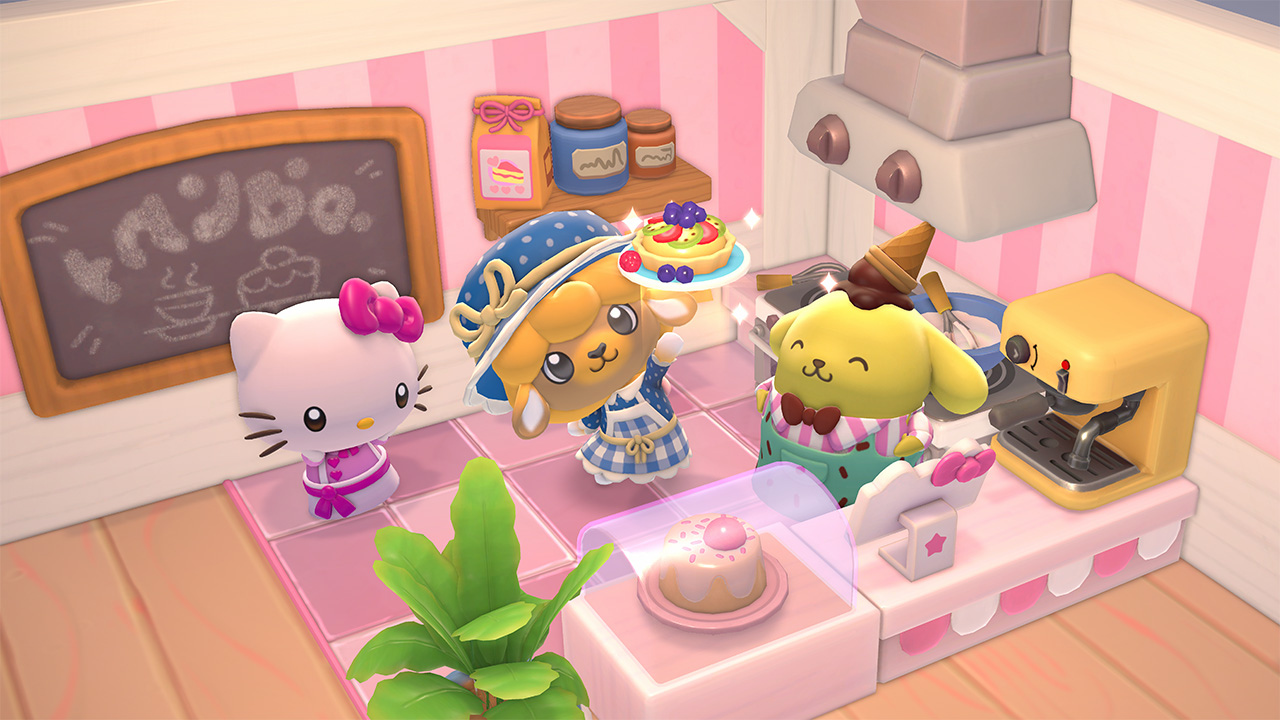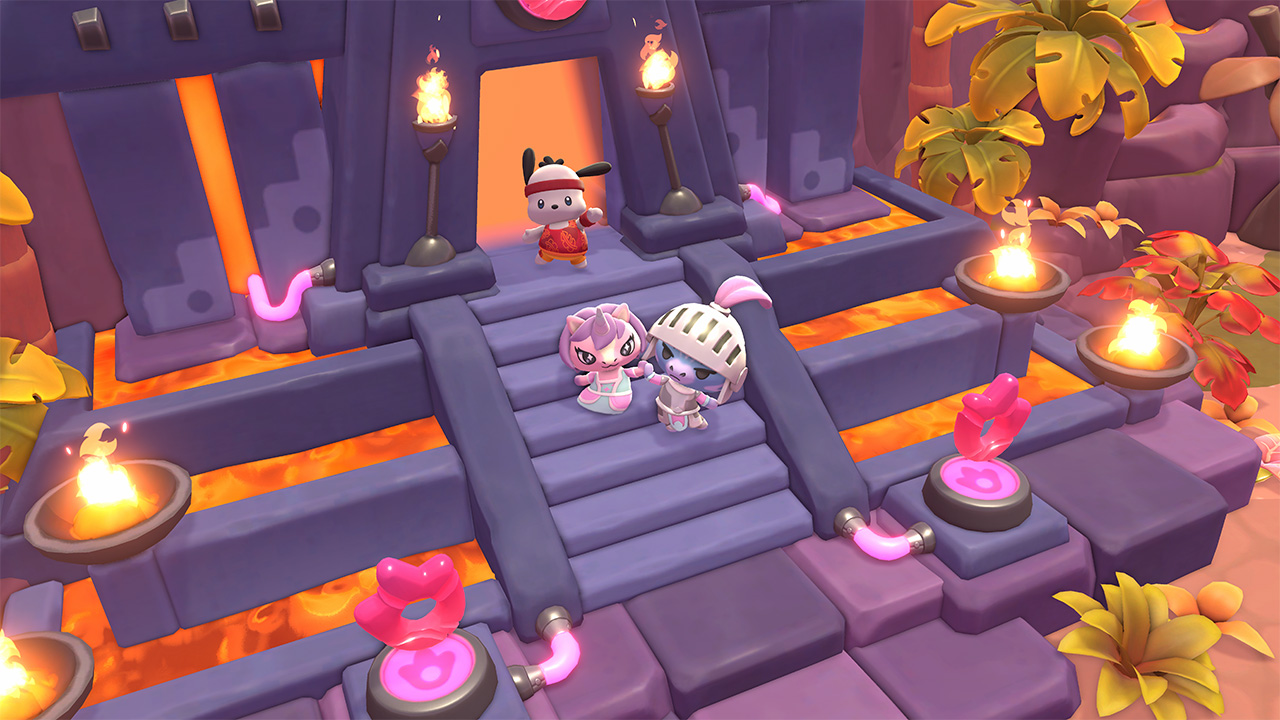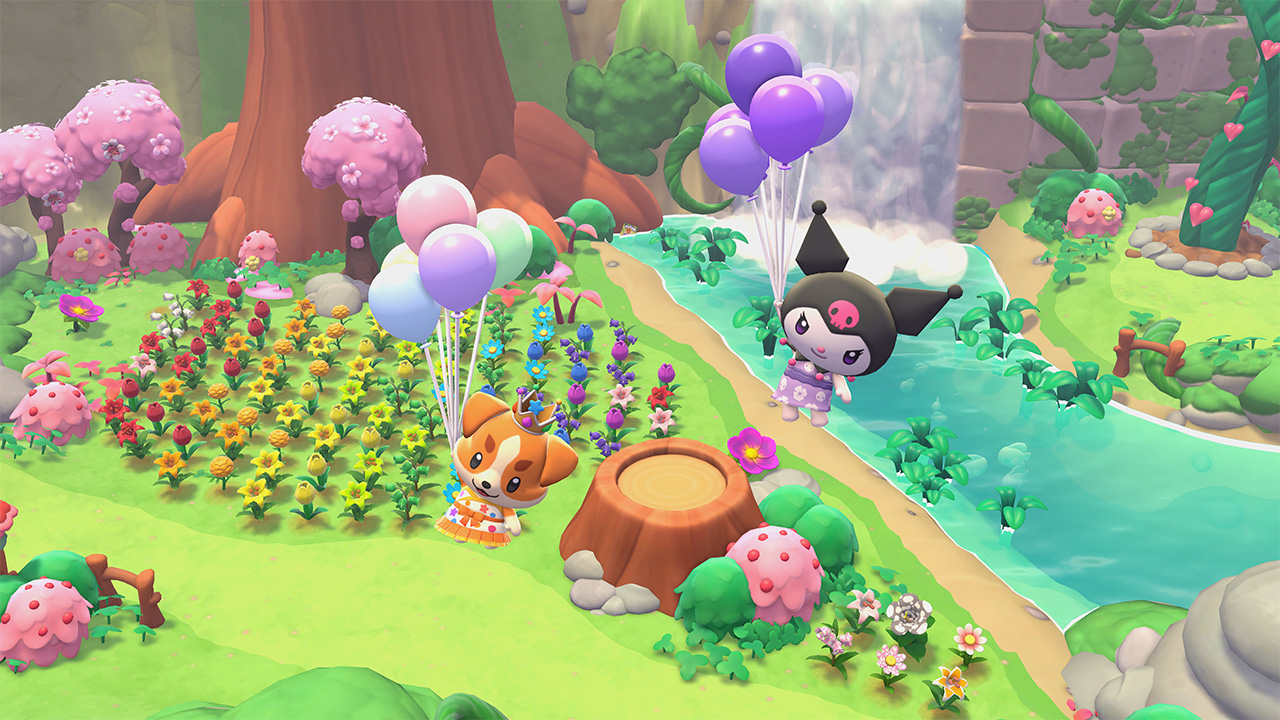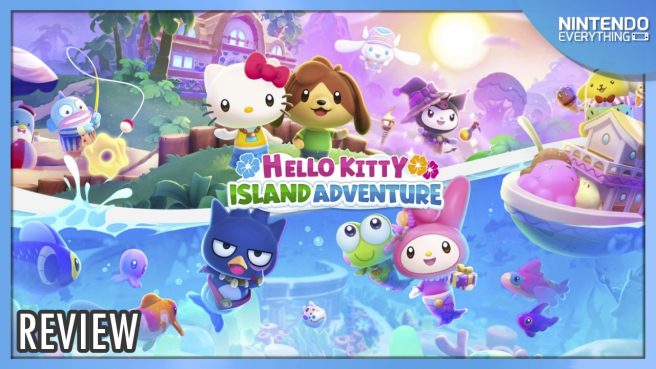Hello Kitty Island Adventure review for Nintendo Switch
System: Switch
Release date: January 30, 2025
Developer: Sunblink
Publisher: Sunblink
What exactly makes a “cozy game” these days? In many cases it seems to be a bit of a misnomer: for every one that transports you into a relaxed world with a gameplay loop that you can take at your own pace, you’ll find two more that will thrust you into a hellscape of seasonal crops, timed events, and needy NPCs that all require more time management and organizational skills than your actual life does. Hello Kitty Island Adventure is thankfully not one of these latter titles, but it hasn’t quite escaped unscathed from its time trapped on Apple Arcade, and this holds it back from being the experience that it feels like it should be on Nintendo Switch.
Island Adventure begins on a plane with Hello Kitty and friends travelling to Big Adventure Park to help My Melody establish a furniture store on the island. The journey becomes slightly turbulent when an attempt to bake a cake for everyone results in some non-threatening explosions and, rather than landing the plane normally to sort everything out, everyone decides to jump out of it instead. Naturally, this scatters them all across the island, making your first task to reunite with everyone and deliver the welcome gifts that My Melody had prepared for them.
This initial goal ties in nicely to Island Adventure’s core focus of exploration as you travel across the island’s highly diverse biomes (which are all naturally sandwiched together with no geographical logic whatsoever) in order to find your friends – all of which are other characters from across the Sanrio franchise. As you continue to explore and deepen your friendship with those you encounter, your focus will shift to uncovering the island’s mysteries, involving the strange locals, the Nuls, and the amnesiac ghostly figure of Tophat, whose memories are tied to the odd structures scattered throughout each area.
You’re given a surprising amount of freedom of movement on your travels: most surfaces are climbable, with the notable exception being volcanic surfaces (trying to scale the volcano will just see your character deposited back to the last safe place they were standing), and you have a handy set of balloons that allow you to glide short distances. The ability to swim and dive are also unlocked fairly early into the game, with your air supply tied to your stamina, which can be upgraded. Running out of stamina underwater will see your character frantically swim to the surface, otherwise unharmed, or slide helplessly off whatever you happened to be climbing at the time. Despite the numerous hazards you’ll encounter on your journey, this is a relaxed, low-stress experience (at least in this regard) with no fail state to speak of, which is about what you would expect of the Sanrio franchise.

Nonetheless, it does take a significant amount of time to unlock everything the island has to offer. Several essential tools are locked behind friend quests or story quests that will take at least a week of consistent daily play and diligent gift-giving to reach. It will take even longer before you can travel to every area in the game, but it’s rare that you’ll feel as though you can’t do something within its confines: if it’s on the map, you can go there, and there is plenty to uncover within that map. If you can’t quite reach a point of interest, once you’ve acquired the right tool or upgraded your stamina a little, then you’ll probably be able to once you go back.
Despite this more hands-off approach, the quest log is nonetheless highly comprehensive for when you want to make more active plot progression, allowing you to see which story quests you can do, any unlock requirements for the ones you can’t, and providing a handy on-screen tracker that you can follow to reach the next point of interest. Fast travel points in the form of post boxes are also generously spaced out across the island’s biomes for quick access as tasks will often require you to travel back and forth between locations to speak to NPCs, or gather resources, or find items. Of course, you can simply choose to disable the quest tracker if you’d prefer to find things naturally, and if you’d rather traverse the lands yourself, you will eventually unlock ziplines for faster access between areas.
Outside of quests there is a satisfyingly large amount of content in Hello Kitty Island Adventure to engage with. Initially it can be quite overwhelming, as the game never provides any clear signposting regarding specific tasks that you need to do to progress, introducing its various side activities organically. Some, like catching critters and fishing, you’ll discover as you befriend the island’s residents and unlock their story quests. If you’re not familiar with Sanrio this is an excellent way to get to know the personalities of the core cast, and if you are, it’s pure fanservice watching them interact with one another in these quests.
The bulk of your time will be spent gathering resources, which can be used for crafting useful items, various different types of food, and for trading for specific furniture or clothing at shops. Giving your friends gifts will result in them giving you a particular resource unique to them in exchange and the resources scattered across the island, while finite in number, will refresh on a daily basis, and shops will also change their stock on a daily basis.

Other activities, such as puzzle rooms, time trial courses, and the various minigames that will reward you with materials or clothing and furniture pieces, won’t be signposted at all, which makes exploration feel particularly rewarding and worthwhile. The puzzle rooms are a particular highlight: none are particularly difficult to solve, but each one is uniquely crafted and has the feeling of a traditional RPG dungeon puzzle, making them a nice break from the normal routine, and most come with a nice prize at the end.
At the very start of the game you are tasked with creating your own Sanrio character from a modest pool of options, and there is a nice level of customization present throughout the game. You can change your avatar’s appearance at any time and will unlock additional color palettes for them as you progress. Most clothing can be dyed, and some pieces even come with their own unique effects. For example, the mermaid costume allows you to swim faster. There is less of an emphasis on decorating than in other life sim titles, but still a wide variety of furniture to choose from to decorate your home, both modelled after Sanrio characters and in the usual array of aesthetics you’d expect to find.
Furniture has a second and arguably more significant function: to customize the many cabins you can open that are scattered across the island’s biomes, to attract the visitors who will come to the island on a daily basis. Each visitor, another Sanrio character with a connection to one your core cast, has their own specific requirements for a dwelling. As one example, Dear Daniel wants a cabin in the Seaside Resort with any three pieces of furniture and Mama’s Apple Pie as a decoration. Meeting these conditions will see him move into that cabin for a limited period of time, and give you the chance to increase your friendship with him by completing a quest. Reaching 5-star friendship will then allow you to invite him to stay on the island permanently.
This is all to say that, unless you play the game excessively, it is extremely difficult to feel as though you are wasting time. Between the daily regeneration of resources, abundance of hidden secrets on the island, and lengthy story quests, everything you do will contribute towards something else, and the feeling of discovery is persistent and always satisfying, even if it’s something as simple as finding another Gutedama to photograph, or adding a new critter to the Nature Preserve. In the short-term at least, Hello Kitty Island Adventure is relaxing, satisfying, and highly rewarding. But therein also lies the biggest problem with the game, which you are practically guaranteed to run into if you play it for long enough: despite being a full-price release on Nintendo Switch, Island Adventure is still a live service title, and in the spirit of all such games, it thoroughly disrespects your time if you invest too much into it.
If you’ve ever dabbled in free to play mobile titles, or live service games in general, you’ll have an idea of what to expect, and here the gatekeeping is tied to story progression. You’ll need to increase your friendship with the island’s various residents in order to unlock story quests, which is done by giving them gifts. Unfortunately, you can only give them three gifts per real day unless you have friendship blossoms or bouquets, which you only receive a couple of times a week as a gift and cannot acquire otherwise. Once you’ve unlocked a quest and completed the first objective, all too often you will then be told to return the following day for the next task, and in some cases this will happen multiple times. Some quests are also locked behind completing other quests first, and these need to be unlocked in turn by raising the friendship level of other characters.

Characters will also need to be available to take part in the quest in the first place. If you’re in the middle of another quest involving them, you will need to finish that one first before you can then start the next. The multitasking that you will be doing with literally every other activity in the game, even if that is as simple as acquiring more resources to craft into items to give as gifts, is strangely absent when it comes to quest progression, where things will often need to be done one at a time, even when there is no reason in the narrative itself for that to apply.
This all results in an intricate spider web of stop-start progression that, although it keeps things varied and has you engaging with almost everything that the island has to offer across all of its biomes at once, also translates into several days’ worth of entirely unnecessary waiting, and long periods where you will be completely unable to make any kind of progress at all. The time sensitivity of events also makes Island Adventure a game that you will need to be constantly engaged with in order to get the most out of it as it demands that you play every single day, but at a pace that it dictates, either forcing you to play more than you otherwise would or wasting your time when you run out of daily content and can’t progress in quests.
After the initial rush of tasks, your time in Hello Kitty Island Adventure boils down to completing daily quests, picking up all of the items that spawn on the island each day (and lack of resources due to this restriction is another block to early game progression in particular when you will need to craft specific items), and giving each resident gifts. It will take many hours spread across weeks of play to reach the point where this is all you have to do when turning it on, and this is a problem that is by no means unique to the game, but for a full price release the over-reliance on this typical live service pacing feels incongruous, and it actively hampers long-term engagement.
Regardless of how much time you spend in Hello Kitty Island Adventure, it endeavors to make your stay a visually pleasing one with a vibrant color palette for each location that perfectly complements the cutesy cast. The Nintendo Switch version specifically does suffer from some slight frame drops at times when moving from place to place, and character movement can stutter when attempting to scale cliffs by jumping (which is far more efficient and likely to succeed than trying to slowly climb them), although these instances are only particularly noticeable if you play for a long period of time and aren’t overly distracting.
The Verdict

Considering the amount of enjoyment I’ve had out of it so far, I wish I could give Hello Kitty Island Adventure a glowing recommendation with no caveats. If you’re someone who has no problems with the live service model, or would put an hour or two a day into this game at the most and therefore wouldn’t notice the arbitrary restrictions it places on you, then consider this review a strong thumbs up, because it is definitely one of the better quality titles that falls under that umbrella, and a perfect fit for the Nintendo Switch. But if you’re wary of live service titles, or would prefer to play a game at your own pace, just keep in mind this isn’t a game that is going to change your mind.
Hello Kitty Island Adventure copy provided by the publisher for the purpose of this review.
